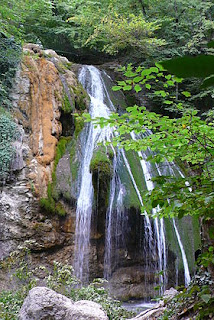The Mandarin Duck
The Mandarin Duck (Aix galericulata), or just Mandarin, is a medium-sized, East Asian perching duck, closely related to the North American Wood Duck. It is 41–49 cm long with a 65–75 cm wingspan.The adult male is a striking and unmistakable bird. It has a red bill, large white crescent above the eye and reddish face and "whiskers". The breast is purple with two vertical white bars, and the flanks ruddy, with two orange "sails" at the back. The female is similar to female Wood Duck, with a white eye-ring and stripe running back from the eye, but is paler below, has a small white flank stripe, and a pale tip to its bill. The Mandarin ducklings are almost identical in look to Wood ducklings, and appear very similar to Mallard ducklings. The ducklings can be distinguished from Mallard ducklings because the eye-stripe of Mandarin ducklings (and Wood ducklings) stops at the eye, while in Mallard ducklings it reaches all the way to the bill.
The species was once widespread in eastern Asia, but large-scale exports and the destruction of its forest habitat have reduced populations in eastern Russia and in China to below 1,000 pairs in each country; Japan, however, is thought to still hold some 5,000 pairs.
Specimens frequently escape from collections, and in the 20th century a large feral population was established in Great Britain; more recently small numbers have bred in Ireland, concentrated in the parks of Dublin. There are now about 7000 in Britain, and other populations on the European continent, the largest in the region of Berlin.
Isolated populations exist in the United States. The town of Black Mountain, North Carolina has a limited population,[citation needed] and there is a free-flying feral population of several hundred mandarins in Sonoma County, California. This population is the result of several mandarin ducks escaping from captivity, then going on to reproduce in the wild.
.jpg)


















































